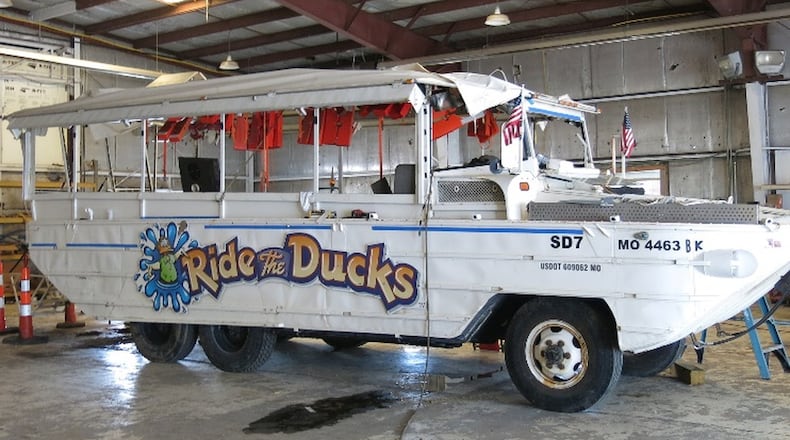Each year, thousands of people flock to Chattanooga for a chance to ride in Alex Moyer’s whimsical boats, which can roam the Tennessee River just as easily as they maneuver the streets of downtown.
Moyers runs his own fleet of World War II “duck boats,” which have been converted into a tourist attraction.
“It’s the novelty of it,’’ Moyers said. “Where else do you get to drive a truck into the river?”
Now, lawsuits filed on behalf of 17 people who died on a duck boat that sank in Missouri this summer have cast doubt on the future operations of the land-sea crafts in tourist spots across the U.S., including at Stone Mountain Park. Lawsuits allege that ride operators and manufacturers, including Norcross-based Herschend Family Entertainment Corp., parent of Ride the Ducks International and Amphibious Vehicle Manufacturing, didn't spend the money to make the duck boats safer, putting profits over lives.
Just days ago, a federal grand jury indicted the boat’s captain on 17 counts involving criminal negligence and misconduct for taking the vessel out in the middle of a severe storm.
Some say shutting down the duck boats is overdue. The tragedy was predictable, they say, because of decades of warnings that the vessels pose dangers on water and on land and dozens of deaths and injuries. But the sea-land vessels have been allowed to continue to operate because they fall under a hodgepodge of state, maritime and federal rules. The National Transportation Safety Board for years has urged boat operators to implement safety changes. The vehicles don’t have to abide by the NTSB’s rules or recommendations, though.
Instead, they are treated like boats and must comply with safety standards imposed by the U.S. Coast Guard, which tries to inspect each vessel in a fleet of 218 every year. In court filings, Ride the Ducks International says that the boat involved in the Missouri accident, like the rest of its vessels, complied with all the Coast Guard safety regulations.
Yet even some private operators, like Moyers, acknowledge that the vessels can be dangerous on water and on land, particularly ones dating back to World War II. Safety inspectors can overlook some of the inherent structural issues that often emerge when the war-era DUKWS are refurbished as tourist attractions.
"These boats are doing something that they were never designed to do," said Doug Dillon, a former Coast Guard official who was among experts who examined the causes of two fatalities in Philadelphia when a duck boat collided with a barge in 2010. "They carry military personnel who were trained and prepared to go into dangerous situations in which people were shooting at them. A little bit of water was not necessarily an issue."
Multiple investigations
Survivors and victims’ families of the Missouri tragedy want duck boats operators to “to cease operations” until safety concerns can be addressed, court records show.
But that’s unlikely to happen until investigators conclude reviews of the cause of the sinking.
The U.S. Coast Guard is running an investigation concurrently with that of the NTSB. The U.S. Attorney for the Western District of Missouri, Southern Division, is looking at whether criminal charges should be filed. The office has asked the judge in the civil suits to halt proceedings until its investigation is done.
So far, a preliminary report indicates that at least one U.S. Coast Guard safety standard was violated. A video recording of the boat at Table Rock Lake in Branson showed wind speeds of up to 65 miles per hour amid a thunderstorm. The boat's certificate of inspection stated that the boat could not be on the water when winds exceeded 35 miles per hour.
Defendants say in court filings that the captain checked the forecast and winds were light when the boat entered the water. Other defendants include Ripley Entertainment, which acquired the Branson attraction in late 2017 from a Herschend subsidiary. Court filings show Ripley wants victims to enter mediation to settle their claims and argues that even if the companies are found negligent, maritime law allows vessel owners to avoid legal damages.
Herschend Family attorney David Dial declined comment in an email, citing ongoing litigation.
Andrew Duffy, one of the attorneys for the families of the victims who died in Missouri, did not return calls.
A ‘Duck” in name only
Moyers and other duck boat operators say it’s unfair to say the industry is full of operators who ignore safety recommendations.
There are at least half a dozen models of duck boats that have safer components and were expressly built as tour vessels, regulators say.
One such operator is Boston Duck Tours, which operates boats that range in age from four to 12 years. The boats that travel on the river and city streets are known as “truck ducks.” According to the company website, the road-water craft are “purpose-built” for tourism. “They share no parts with a WWII DUKW and are a ‘Duck’ in name only,” according to the company’s website.
Moyers operates war-era DUKWs. But he said only the hulls and axles belong to the original vessels. He’s updated most parts, including the engine and transmission, and adopted most of the recommendations that NTSB made after a 1999 duck boat accident in Arkansas in which 13 people drowned.
His boats, for example, carry at least five bilge pumps that have the capacity to draw up hundreds of gallons of water per minute, if they start to flood. He uses radios and safety sensors to detect instances of flooding; the canopy is also retractable. He said he keeps extra safety jackets for passengers and doesn’t carry more than 25 people per excursion.
Among his staff are freighter operators with more than 14 years of experience, he said. And he makes sure the boats are no further away than 50 yards from shore in case of an emergency.
A Coast Guard inspector examined his boats shortly after the Missouri accident and found them to be safe, he said.
Voluntary compliance
No one knows how many duck boat operators adopted the recommendations NTSB made after the Arkansas deaths, because NTSB doesn’t have the authority to require that operators comply.
Lawsuits filed by Missouri plaintiffs’ attorneys allege that the operators had not made changes to make the vessel less vulnerable to flooding and sinking and also hadn’t addressed concerns that the canopies could trap passengers if the boat overturns or sinks. In the fatalities in Missouri, as well as in Arkansas and Philadelphia, an overhead canopy was blamed for the deaths because it created a net that did not allow passengers to escape.
Dillon, the former Coast Guard official, said these issues emerged after the boats were restored as tourist attractions. He said the makeshift canopy was not part of the original design of the troop-transport. It was later added to provide comfort to tourists, he said.
“The military vessels were open top,’’ said Dillon, who is the executive director of the Tri-state Maritime Safety Association, a group of emergency response and maritime officials in Delaware, New Jersey and Pennsylvania.
In its annual inspections, the Coast Guard is required to assess the safety of the canopies. But if the boats are later modified, and many are, it could create unsafe conditions, said Chief Petty Officer Kip Wadlow, a spokesman for the U.S. Coast Guard.
A spokeswoman at Stone Mountain told the AJC that the park conducts a third-party audit to ensure safe operations of its rides and attractions. In more than 1 million rides over 14 years of operations, “there has been no accidents that involved guest injury or vehicle damage,” Angela Watson wrote in an email.
Moyers, who is closely watching the results of the litigation, said it will be tough to find fault with the boat’s mechanics if it is discovered that human error played a major role in the tragedy.
The lawsuits allege that the captain violated protocol by never instructing passengers to put on life jackets, and that lowering the plastic side curtains made it impossible for them to escape. The criminal indictment also says that the captain didn’t properly evaluate weather conditions or tell passengers to put on their life vests.
"You can have as many laws as you want to, but if people aren't following the laws, you know?" he said. "It's like people running red lights. It's against the law to run a red light. You might kill somebody and it's a big deal."
Dillon, the former Coast Guard official, said he’s been on a war-era duck boat. But he always makes sure he has an exit route.
His advice to riders: “I would pick one that didn’t have covers on it, and I’d pick a spot where I knew I could get out.”
About the Author
Keep Reading
The Latest
Featured



